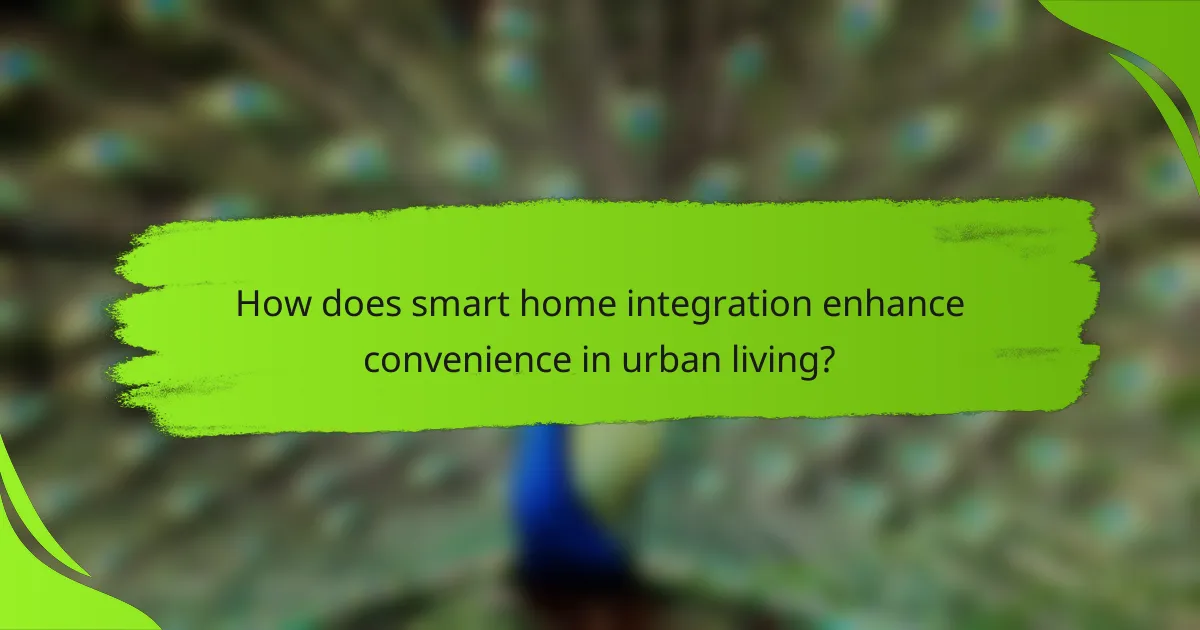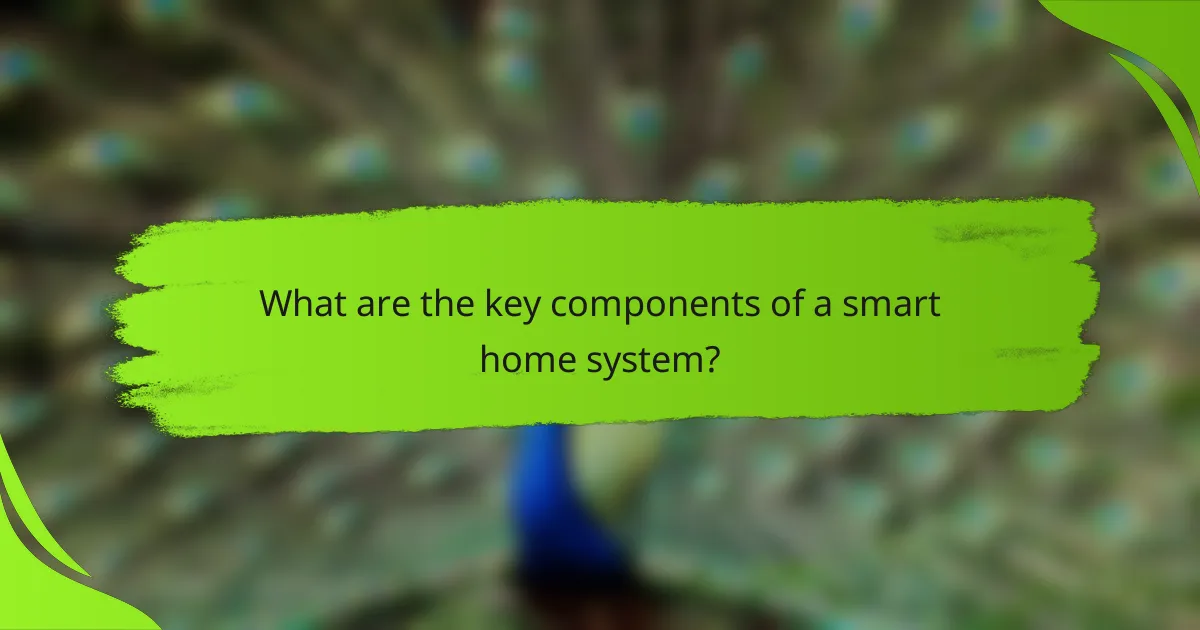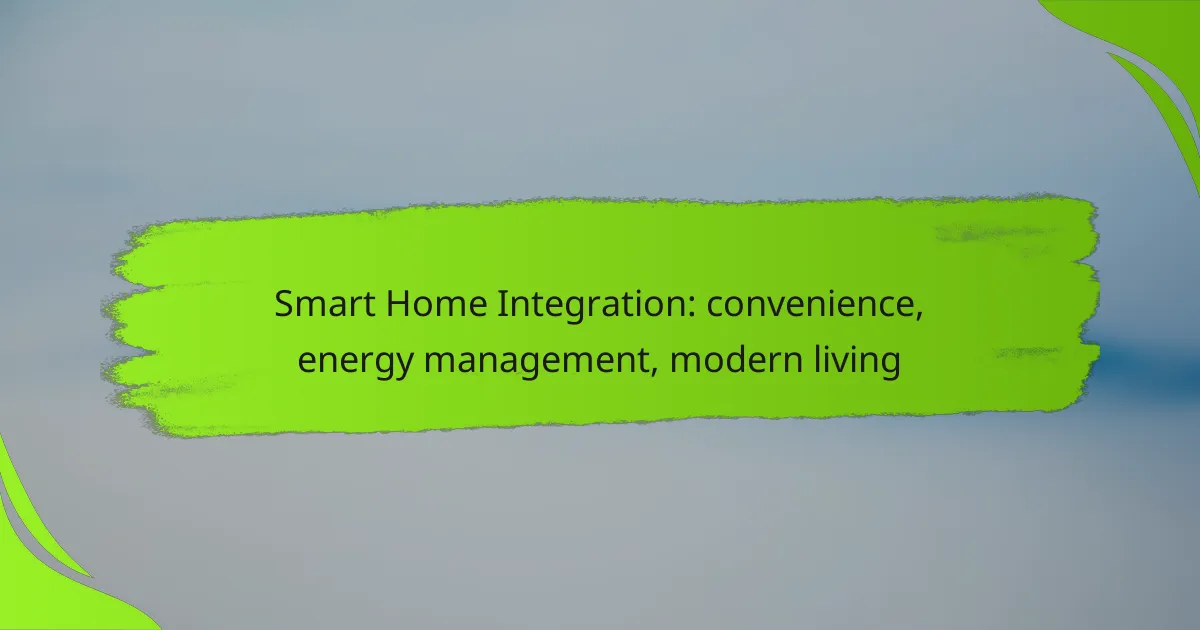Smart home integration revolutionizes modern living by automating daily tasks and providing effortless control over household devices. This technology not only enhances convenience but also optimizes energy management, leading to reduced consumption and lower utility costs. By embracing smart home solutions, residents can enjoy a more efficient and comfortable lifestyle while minimizing their environmental impact.

How does smart home integration enhance convenience in urban living?
Smart home integration significantly enhances convenience in urban living by automating daily tasks and providing seamless control over various devices. This technology allows residents to manage their home environment efficiently, saving time and effort while improving overall quality of life.
Voice-controlled devices
Voice-controlled devices streamline interactions within a smart home, allowing users to execute commands hands-free. Popular options include smart speakers and virtual assistants that can control lighting, temperature, and entertainment systems through simple voice commands.
Consider integrating devices that support multiple languages or accents to ensure accessibility for all household members. Popular platforms like Amazon Alexa and Google Assistant offer extensive compatibility with various smart home products.
Automated lighting systems
Automated lighting systems enhance convenience by allowing users to schedule lighting based on their routines or control it remotely. These systems can adjust brightness and color temperature, creating the perfect ambiance for any occasion.
For optimal energy efficiency, consider using LED bulbs with smart dimmers that can be programmed to turn off when not needed. Many systems also offer motion sensors that automatically activate lights when someone enters a room, further enhancing convenience.
Smart locks and security
Smart locks provide enhanced security and convenience by allowing users to lock and unlock doors remotely via smartphone apps. This feature is particularly useful for urban dwellers who may have multiple entry points or frequently host guests.
When selecting smart locks, look for models that offer keyless entry options, temporary access codes for visitors, and integration with existing security systems. Ensure that the chosen lock complies with local security standards for added peace of mind.
Remote access via mobile apps
Remote access through mobile apps allows users to monitor and control their smart home devices from anywhere, providing unmatched convenience. This capability is essential for urban residents who may be away from home for extended periods.
Choose apps that offer user-friendly interfaces and comprehensive control over all connected devices. Regularly update the app and devices to ensure security and access to the latest features, enhancing the overall smart home experience.

What are the benefits of energy management through smart home technology?
Energy management through smart home technology offers significant advantages, including reduced energy consumption and lower utility bills. By integrating smart devices, homeowners can optimize their energy use, leading to both financial savings and a reduced environmental footprint.
Energy-efficient appliances
Energy-efficient appliances are designed to use less energy while maintaining performance. These devices often carry an Energy Star label, indicating they meet strict efficiency guidelines set by the U.S. Environmental Protection Agency or equivalent bodies in other countries.
When selecting appliances, consider models that consume significantly less energy compared to standard options. For example, an energy-efficient refrigerator can use up to 50% less energy than older models, translating to savings on monthly electricity bills.
Smart thermostats
Smart thermostats automatically adjust heating and cooling settings based on user behavior and preferences. These devices learn your schedule and can optimize energy use by reducing heating or cooling when you’re not home.
Many smart thermostats can save homeowners around 10-15% on heating and cooling costs annually. Features like remote access and integration with other smart home systems enhance convenience and efficiency, allowing for adjustments from anywhere using a smartphone.
Real-time energy monitoring
Real-time energy monitoring systems provide insights into energy usage patterns, helping homeowners identify areas for improvement. These systems can track consumption by appliance, allowing for targeted energy-saving strategies.
Some monitoring solutions offer alerts for unusual energy spikes, which can indicate inefficiencies or malfunctioning devices. By understanding energy consumption in real-time, homeowners can make informed decisions about usage, potentially reducing costs by 5-20% monthly.

How can smart home integration improve daily routines?
Smart home integration enhances daily routines by automating tasks and providing greater control over household systems. This technology streamlines activities, improves energy management, and contributes to a more efficient and comfortable living environment.
Scheduled automation
Scheduled automation allows users to set specific times for devices to operate, reducing the need for manual intervention. For example, you can program your lights to turn on at sunset or your thermostat to adjust temperatures before you arrive home. This not only saves time but can also lead to energy savings by optimizing usage patterns.
To implement scheduled automation effectively, consider the daily routines of all household members. Use a smart home app to create schedules that align with your lifestyle, ensuring that devices operate when they are most needed. Avoid overlapping schedules that could lead to unnecessary energy consumption.
Customizable scenes
Customizable scenes allow users to create specific settings that adjust multiple devices simultaneously with a single command. For instance, a “Movie Night” scene could dim the lights, close the blinds, and turn on the TV, all at once. This feature enhances convenience and can significantly improve the ambiance of your home.
When setting up customizable scenes, think about the activities you frequently engage in. Group devices that work together and test the scenes to ensure they function as intended. Regularly update these scenes to reflect changes in your preferences or household dynamics, ensuring they remain relevant and useful.

What are the key components of a smart home system?
A smart home system typically consists of smart hubs, IoT devices, and wireless protocols that work together to enhance convenience and energy management. These components allow for seamless integration and control of various home functions, making modern living more efficient and user-friendly.
Smart hubs
Smart hubs serve as the central control unit for a smart home system, connecting various devices and enabling communication between them. They often support multiple protocols, allowing for diverse device compatibility, which simplifies management through a single interface.
When choosing a smart hub, consider factors such as compatibility with existing devices, ease of use, and the ability to integrate with voice assistants like Amazon Alexa or Google Assistant. Popular options include Samsung SmartThings and Amazon Echo Plus.
IoT devices
IoT devices are the physical components of a smart home, including smart lights, thermostats, cameras, and locks. These devices collect and share data, allowing homeowners to monitor and control their environment remotely.
When selecting IoT devices, prioritize those that offer energy efficiency and compatibility with your smart hub. For example, smart thermostats can significantly reduce energy consumption by learning your schedule and adjusting temperatures accordingly.
Wireless protocols
Wireless protocols are the communication standards that enable devices to connect and interact within a smart home system. Common protocols include Wi-Fi, Zigbee, and Z-Wave, each with its own advantages and limitations.
Wi-Fi is widely used for its high-speed connectivity but may consume more energy. Zigbee and Z-Wave are designed for low-power devices, making them ideal for battery-operated sensors. Evaluate your needs to choose the right protocol for your smart home setup.

What factors should be considered when choosing smart home devices?
When selecting smart home devices, consider compatibility, brand reputation, and the balance between cost and functionality. These factors ensure that your devices work seamlessly together and provide reliable performance without overspending.
Compatibility with existing systems
Compatibility is crucial for a cohesive smart home experience. Ensure that new devices can integrate with your current systems, such as smart hubs, voice assistants, or security setups. Check for compatibility with popular protocols like Zigbee, Z-Wave, or Wi-Fi.
For example, if you already have a smart thermostat that operates on Zigbee, adding devices that support the same protocol will enhance connectivity and control. Always verify compatibility before making a purchase to avoid integration issues.
Brand reputation and support
Choosing reputable brands can significantly impact your smart home experience. Established brands often provide better customer support, regular software updates, and reliable product quality. Research user reviews and ratings to gauge brand performance.
Additionally, consider the availability of customer service and warranty options. Brands with responsive support can help resolve issues quickly, ensuring your devices function as intended.
Cost vs. functionality
Evaluate the cost of smart home devices against their features and functionality. While lower-priced options may seem appealing, they might lack essential features or durability. Determine which functionalities are necessary for your lifestyle and budget accordingly.
For instance, a smart light bulb may cost less but might not offer features like color changing or scheduling, which could be more beneficial in the long run. Weigh the initial investment against potential energy savings and convenience to make an informed decision.

How do smart home systems contribute to sustainability?
Smart home systems enhance sustainability by optimizing energy consumption and reducing waste. By integrating devices that monitor and control energy use, homeowners can significantly lower their carbon footprint and utility bills.
Energy Efficiency
Smart home systems improve energy efficiency through automation and real-time monitoring. Devices like smart thermostats adjust heating and cooling based on occupancy patterns, potentially reducing energy use by 10-20%. Smart lighting systems can dim or turn off lights when rooms are unoccupied, further conserving electricity.
Water Conservation
Smart home technology can also aid in water conservation. Smart irrigation systems use weather data to optimize watering schedules, which can save significant amounts of water—up to 50% in some cases. Additionally, smart leak detectors can alert homeowners to leaks, preventing water waste and costly damage.
Waste Reduction
Smart home systems help reduce waste by enabling better management of resources. For instance, smart refrigerators can track food inventory and suggest recipes based on what is available, minimizing food spoilage. Smart composting systems can also assist in managing organic waste more effectively.
Renewable Energy Integration
Many smart home systems facilitate the use of renewable energy sources. Homeowners can monitor solar panel output and battery storage levels through smart apps, ensuring optimal use of generated energy. This integration not only supports sustainability but can also lead to lower energy costs over time.
Environmental Monitoring
Smart home systems can monitor environmental conditions, providing data that helps homeowners make informed decisions. For example, air quality sensors can detect pollutants and suggest ventilation strategies, improving indoor air quality while promoting health and sustainability. This proactive approach can lead to a more sustainable living environment overall.
